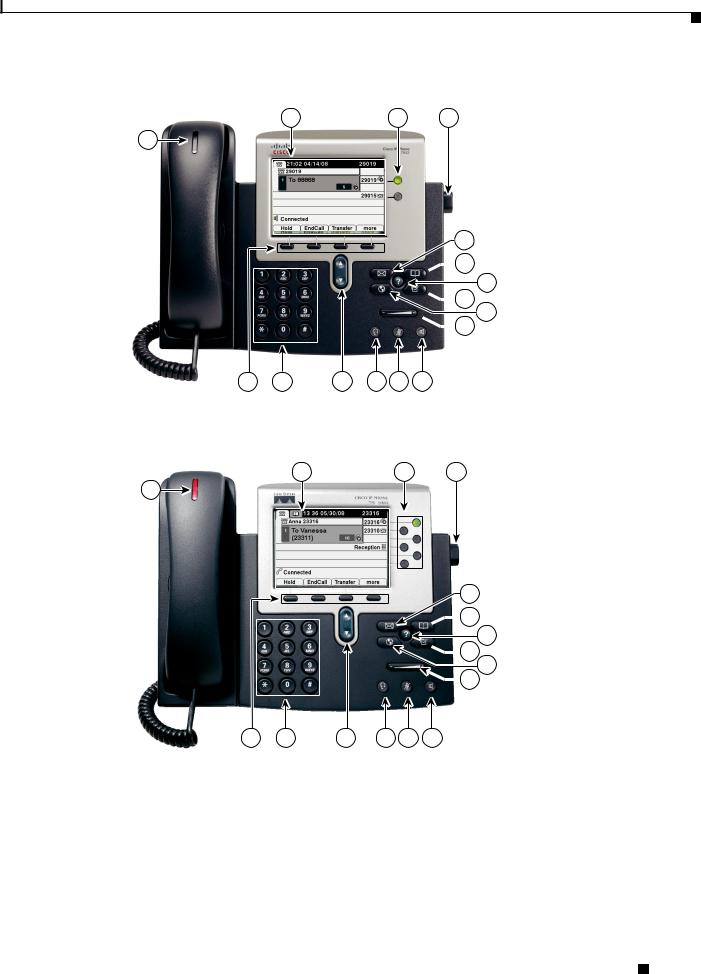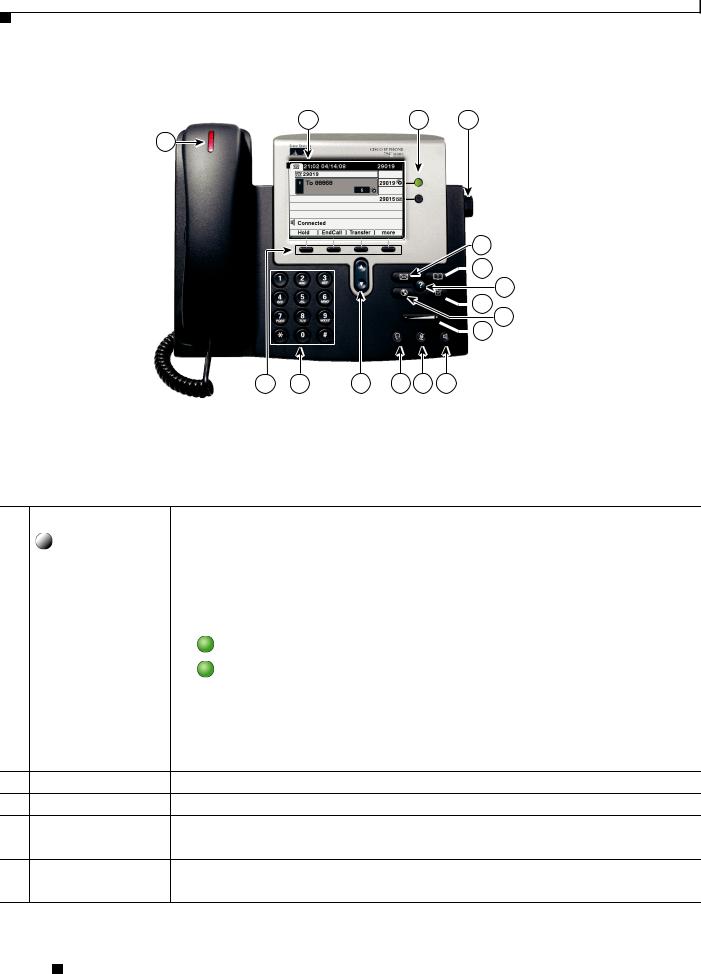Cisco Communications Manager 8.6 User Manual

Cisco Unified IP Phone Administration Guide for Cisco Unified Communications Manager 8.6 (SCCP and SIP)
For Cisco Unified IP Phones 7962G, 7942G, 7961G, 7961G-GE, 7941G, and 7941G-GE
Americas Headquarters
Cisco Systems, Inc. 170 West Tasman Drive
San Jose, CA 95134-1706 USA http://www.cisco.com Tel: 408 526-4000
800 553-NETS (6387) Fax: 408 527-0883
Text Part Number: OL-23091-01

THE SPECIFICATIONS AND INFORMATION REGARDING THE PRODUCTS IN THIS MANUAL ARE SUBJECT TO CHANGE WITHOUT NOTICE. ALL STATEMENTS, INFORMATION, AND RECOMMENDATIONS IN THIS MANUAL ARE BELIEVED TO BE ACCURATE BUT ARE PRESENTED WITHOUT WARRANTY OF ANY KIND, EXPRESS OR IMPLIED. USERS MUST TAKE FULL RESPONSIBILITY FOR THEIR APPLICATION OF ANY PRODUCTS.
THE SOFTWARE LICENSE AND LIMITED WARRANTY FOR THE ACCOMPANYING PRODUCT ARE SET FORTH IN THE INFORMATION PACKET THAT SHIPPED WITH THE PRODUCT AND ARE INCORPORATED HEREIN BY THIS REFERENCE. IF YOU ARE UNABLE TO LOCATE THE SOFTWARE LICENSE OR LIMITED WARRANTY, CONTACT YOUR CISCO REPRESENTATIVE FOR A COPY.
The following information is for FCC compliance of Class A devices: This equipment has been tested and found to comply with the limits for a Class A digital device, pursuant to part 15 of the FCC rules. These limits are designed to provide reasonable protection against harmful interference when the equipment is operated in a commercial environment. This equipment generates, uses, and can radiate radio-frequency energy and, if not installed and used in accordance with the instruction manual, may cause harmful interference to radio communications. Operation of this equipment in a residential area is likely to cause harmful interference, in which case users will be required to correct the interference at their own expense.
The following information is for FCC compliance of Class B devices: The equipment described in this manual generates and may radiate radio-frequency energy. If it is not installed in accordance with Cisco’s installation instructions, it may cause interference with radio and television reception. This equipment has been tested and found to comply with the limits for a Class B digital device in accordance with the specifications in part 15 of the FCC rules. These specifications are designed to provide reasonable protection against such interference in a residential installation. However, there is no guarantee that interference will not occur in a particular installation.
Modifying the equipment without Cisco’s written authorization may result in the equipment no longer complying with FCC requirements for Class A or Class B digital devices. In that event, your right to use the equipment may be limited by FCC regulations, and you may be required to correct any interference to radio or television communications at your own expense.
You can determine whether your equipment is causing interference by turning it off. If the interference stops, it was probably caused by the Cisco equipment or one of its peripheral devices. If the equipment causes interference to radio or television reception, try to correct the interference by using one or more of the following measures:
•Turn the television or radio antenna until the interference stops.
•Move the equipment to one side or the other of the television or radio.
•Move the equipment farther away from the television or radio.
•Plug the equipment into an outlet that is on a different circuit from the television or radio. (That is, make certain the equipment and the television or radio are on circuits controlled by different circuit breakers or fuses.)
Modifications to this product not authorized by Cisco Systems, Inc. could void the FCC approval and negate your authority to operate the product.
The Cisco implementation of TCP header compression is an adaptation of a program developed by the University of California, Berkeley (UCB) as part of UCB’s public domain version of the UNIX operating system. All rights reserved. Copyright © 1981, Regents of the University of California.
NOTWITHSTANDING ANY OTHER WARRANTY HEREIN, ALL DOCUMENT FILES AND SOFTWARE OF THESE SUPPLIERS ARE PROVIDED “AS IS” WITH ALL FAULTS. CISCO AND THE ABOVE-NAMED SUPPLIERS DISCLAIM ALL WARRANTIES, EXPRESSED OR IMPLIED, INCLUDING, WITHOUT LIMITATION, THOSE OF MERCHANTABILITY, FITNESS FOR A PARTICULAR PURPOSE AND NONINFRINGEMENT OR ARISING FROM A COURSE OF DEALING, USAGE, OR TRADE PRACTICE.
IN NO EVENT SHALL CISCO OR ITS SUPPLIERS BE LIABLE FOR ANY INDIRECT, SPECIAL, CONSEQUENTIAL, OR INCIDENTAL DAMAGES, INCLUDING, WITHOUT LIMITATION, LOST PROFITS OR LOSS OR DAMAGE TO DATA ARISING OUT OF THE USE OR INABILITY TO USE THIS MANUAL, EVEN IF CISCO OR ITS SUPPLIERS HAVE BEEN ADVISED OF THE POSSIBILITY OF SUCH DAMAGES.
Cisco and the Cisco Logo are trademarks of Cisco Systems, Inc. and/or its affiliates in the U.S. and other countries. A listing of Cisco's trademarks can be found at www.cisco.com/go/trademarks. Third party trademarks mentioned are the property of their respective owners. The use of the word partner does not imply a partnership relationship between Cisco and any other company. (1005R)
Cisco Unified IP Phone Administration Guide for Cisco Unified Communications Manager 8.6 (SCCP and SIP)
The Java logo is a trademark or registered trademark of Sun Microsystems, Inc. in the U.S. or other countries.
© 2011 Cisco Systems, Inc. All rights reserved.

|
|
|
|
|
|
C O N T E N T S |
|
|
Preface xi |
|
|
|
|
|
|
|
Overview |
xi |
|
|
|
|
|
|
Audience |
xi |
|
|
|
|
|
|
Organization |
xi |
|
|
|
|
|
|
Related Documentation |
xii |
|
|
|
||
|
Obtaining Documentation, Obtaining Support, and Security Guidelines |
xiii |
|||||
|
Cisco Product Security Overview |
xiii |
|
|
|||
|
Document Conventions |
xiii |
|
|
|
||
|
An Overview of the Cisco Unified IP Phones |
|
|
||||
C H A P T E R 1 |
1-1 |
|
|||||
|
Understanding the Cisco Unified IP Phone 7962G and 7942G 7962G, 7942G, 7961G, 7961G-GE, 7941G, |
||||||
|
and 7941G-GE |
1-2 |
|
|
|
|
|
|
What Networking Protocols are Used? |
1-5 |
|
|
|||
|
IPv6 Support on Cisco Unified IP Phones |
1-8 |
|
||||
|
What Features are Supported on the Cisco Unified IP Phone 7962G and 7942G? 1-9 |
||||||
|
Feature Overview |
1-10 |
|
|
|
||
|
Configuring Telephony Features |
1-10 |
|
|
|||
|
Configuring Network Parameters Using the Cisco Unified IP Phones |
1-11 |
|||||
|
Providing Users with Feature Information |
1-11 |
|
||||
|
Understanding Security Features for Cisco Unified IP Phones 1-11 |
|
|||||
|
Overview of Supported Security Features |
1-13 |
|
||||
|
Understanding Security Profiles |
1-15 |
|
|
|||
|
Identifying Authenticated, Encrypted, and Protected Phone Calls |
1-15 |
|
|
|
||
|
Establishing and Identifying Secure Conference Calls |
1-16 |
|
|
|
|
|
|
Establishing and Identifying Protected Calls |
1-17 |
|
|
|
|
|
|
Call Security Interactions and Restrictions |
1-17 |
|
|
|
|
|
|
Supporting 802.1X Authentication on Cisco Unified IP Phones |
1-19 |
|
|
|
||
|
Overview 1-19 |
|
|
|
|
|
|
|
Required Network Components 1-19 |
|
|
|
|
|
|
|
Best Practices—Requirements and Recommendations |
1-20 |
|
|
|
||
|
Security Restrictions 1-21 |
|
|
|
|
|
|
|
Reducing Power Consumption on the Phones 1-21 |
|
|
|
|
|
|
|
Overview of Configuring and Installing Cisco Unified IP Phones |
1-21 |
|
|
|
||
|
Configuring Cisco Unified IP Phones in Cisco Unified Communications Manager 1-21 |
||||||
|
Cisco Unified IP Phone Administration Guide for Cisco Unified Communications Manager 8.6 (SCCP and SIP) |
|
|
|
|||
|
|||||||
|
|
|
|
|
|
|
|
|
OL-23091-01 |
|
|
|
|
iii |
|
|
|
|
|
|
|
||

Contents
Checklist for Configuring the Cisco Unified IP Phones in Cisco Unified Communications Manager
Administrations
|
Installing Cisco Unified IP Phones 1-25 |
|
|
Checklist for Installing the Cisco Unified IP Phones 1-25 |
|
|
Preparing to Install the Cisco Unified IP Phones on Your Network 2-1 |
|
C H A P T E R 2 |
|
|
|
Understanding Interactions with Other Cisco Unified IP Telephony Products |
2-1 |
|
Understanding How the Cisco Unified IP Phones Interact with Cisco Unified Communications |
|
|
Manager 2-2 |
|
|
Understanding How the Cisco Unified IP Phones Interact with the VLAN |
2-2 |
|
Providing Power to the Cisco Unified IP Phones 2-3 |
|
|
Power Guidelines 2-4 |
|
|
Power Outage 2-4 |
|
|
Obtaining Additional Information about Power 2-5 |
|
||||||
|
Understanding Phone Configuration Files |
2-5 |
|
|
|
|||
|
Understanding the Phone Startup Process |
2-7 |
|
|
|
|||
|
Adding Phones to the Cisco Unified Communications Manager Database 2-8 |
|||||||
|
Adding Phones with Auto-Registration 2-9 |
|
|
|||||
|
Adding Phones with Auto-Registration and TAPS |
2-10 |
|
|||||
|
Adding Phones with Cisco Unified Communications Manager Administration 2-11 |
|||||||
|
Adding Phones with BAT |
2-11 |
|
|
|
|
||
|
Using Cisco Unified IP Phones with Different Protocols |
2-12 |
|
|||||
|
Converting a New Phone from SCCP to SIP |
2-12 |
|
|
||||
|
Converting an In-Use Phone from One Protocol to the Other 2-13 |
|||||||
|
Deploying a Phone in an SCCP and SIP Environment |
2-13 |
||||||
|
Determining the MAC Address for a Cisco Unified IP Phones |
2-13 |
||||||
|
Setting Up the Cisco Unified IP Phones |
|
|
|
|
|||
C H A P T E R 3 |
3-1 |
|
|
|
||||
|
Before You Begin |
3-1 |
|
|
|
|
|
|
|
Network Requirements 3-2 |
|
|
|
|
|||
|
Cisco Unified Communications Manager Configuration |
3-2 |
||||||
|
Understanding the Cisco Unified IP Phone Components |
3-2 |
|
|||||
|
Network and Access Ports |
3-3 |
|
|
|
|
||
|
Handset |
3-3 |
|
|
|
|
|
|
|
Speakerphone |
3-4 |
|
|
|
|
|
|
|
Headset |
3-4 |
|
|
|
|
|
|
|
Audio Quality Subjective to the User |
3-4 |
|
|
||||
|
Connecting a Headset |
3-4 |
|
|
|
|
||
|
Disabling a Headset |
3-5 |
|
|
|
|
||
Cisco Unified IP Phone Administration Guide for Cisco Unified Communications Manager 8.6 (SCCP and SIP)
|
iv |
OL-23091-01 |
|
|
|

Contents
|
Enabling a Wireless Headset on the Cisco Unified IP Phones 3-5 |
|||||||
|
Using External Devices |
3-5 |
|
|
|
|
|
|
|
Installing the Cisco Unified IP Phones |
3-6 |
|
|
|
|
||
|
Attaching a Cisco Unified IP Phone Expansion Module |
3-9 |
|
|||||
|
Feature Key Capacity Increase for Cisco Unified IP Phones |
3-10 |
||||||
|
Adjusting the Placement of the Cisco Unified IP Phone |
3-11 |
|
|||||
|
Adjusting Cisco Unified IP Phone Placement on the Desktop |
3-11 |
||||||
|
Securing the Phone with a Cable Lock |
3-12 |
|
|
|
|||
|
Mounting the Phone to the Wall |
3-12 |
|
|
|
|
||
|
Verifying the Phone Startup Process |
3-14 |
|
|
|
|
||
|
Configuring Startup Network Settings |
3-15 |
|
|
|
|||
|
Configuring Security on the Cisco Unified IP Phones |
|
3-15 |
|
||||
|
Configuring Settings on the Cisco Unified IP Phones |
|
|
|||||
C H A P T E R 4 |
4-1 |
|
||||||
|
Configuration Menus on the Cisco Unified IP Phones |
4-1 |
|
|||||
|
Displaying a Configuration Menu |
4-2 |
|
|
|
|
||
|
Unlocking and Locking Options |
4-2 |
|
|
|
|
||
|
Editing Values 4-3 |
|
|
|
|
|
|
|
|
Overview of Options Configurable from a Phone 4-4 |
|
|
|||||
|
Network Configuration Menu |
4-5 |
|
|
|
|
|
|
|
Understanding DHCPv6 and Autoconfiguration |
4-17 |
|
|||||
|
Device Configuration Menu |
4-18 |
|
|
|
|
|
|
|
Unified CM Configuration Menu |
4-19 |
|
|
|
|
||
|
SIP Configuration Menu for SIP Phones Only |
4-20 |
|
|||||
|
SIP General Configuration Menu |
4-20 |
|
|
|
|||
|
Line Settings Menu for SIP Phones |
4-21 |
|
|
|
|||
|
Call Preferences Menu for SIP Phones |
4-22 |
|
|
|
|||
|
HTTP Configuration Menu |
4-23 |
|
|
|
|
|
|
|
Locale Configuration Menu |
4-24 |
|
|
|
|
||
|
NTP Configuration Menu for SIP Phones |
4-25 |
|
|||||
|
UI Configuration Menu |
4-26 |
|
|
|
|
|
|
|
Media Configuration Menu |
4-28 |
|
|
|
|
||
|
Ethernet Configuration Menu |
4-31 |
|
|
|
|
||
|
Security Configuration Menu |
4-32 |
|
|
|
|
||
|
QoS Configuration Menu |
4-33 |
|
|
|
|
|
|
|
Network Configuration Menu |
4-34 |
|
|
|
|
||
|
Security Configuration Menu |
4-39 |
|
|
|
|
|
|
|
CTL File Submenu 4-40 |
|
|
|
|
|
|
|
Cisco Unified IP Phone Administration Guide for Cisco Unified Communications Manager 8.6 (SCCP and SIP)
|
OL-23091-01 |
v |
|

Contents
|
ITL File Submenu |
4-41 |
|
|
|
|
Trust List Menu |
4-43 |
|
|
|
|
802.1X Authentication and Status |
4-44 |
|
||
|
VPN Configuration 4-46 |
|
|
|
|
|
Connecting to VPN |
4-46 |
|
|
|
|
VPN Configuration Settings |
4-47 |
|
||
|
Configuring Features, Templates, Services, and Users |
|
|||
C H A P T E R 5 |
5-1 |
||||
|
Telephony Features Available for the Cisco Unified IP Phone 5-1 |
||||
|
Configuring Product Specific Configuration Parameters |
5-22 |
|||
|
Configuring Corporate and Personal Directories 5-24 |
|
|||
|
Configuring Corporate Directories |
5-24 |
|
||
|
Configuring Personal Directory 5-24 |
|
|||
|
Modifying Phone Button Templates |
5-25 |
|
||
|
Modifying a Phone Button Template for Personal Address Book or Fast Dials 5-26 |
||||
|
Configuring Softkey Templates |
5-27 |
|
|
|
|
Setting Up Services |
5-28 |
|
|
|
|
Adding Users to Cisco Unified Communications Manager |
5-28 |
|
||||
|
Managing the User Options Web Pages |
5-29 |
|
|
|
|
|
|
Giving Users Access to the User Options Web Pages |
5-29 |
|
||||
|
Specifying Options that Appear on the User Options Web Pages |
5-30 |
|||||
|
Enabling EnergyWise on the Cisco Unified IP Phone |
5-31 |
|
|
|||
|
Setting up UCR 2008 5-34 |
|
|
|
|
|
|
|
Configuring UCR 2008 in Phone |
5-34 |
|
|
|
|
|
|
Configuring UCR 2008 in Common Phone Profile |
5-35 |
|
||||
|
Configuring UCR 2008 in Enterprise Phone Configuration |
5-35 |
|||||
|
Customizing the Cisco Unified IP Phones |
|
|
|
|
|
|
C H A P T E R 6 |
6-1 |
|
|
|
|
||
|
Customizing and Modifying Configuration Files |
6-1 |
|
|
|
||
|
Creating Custom Phone Rings |
6-2 |
|
|
|
|
|
|
Ringlist.xml File Format Requirements 6-2 |
|
|
|
|
||
|
PCM File Requirements for Custom Ring Types |
6-3 |
|
|
|||
|
Configuring a Custom Phone Ring |
6-3 |
|
|
|
|
|
|
Creating Custom Background Images 6-3 |
|
|
|
|
||
|
List.xml File Format Requirements |
6-4 |
|
|
|
|
|
|
PNG File Requirements for Custom Background Images |
6-5 |
|
||||
|
Configuring a Custom Background Image |
6-5 |
|
|
|
||
|
Configuring Wideband Codec |
6-6 |
|
|
|
|
|
Cisco Unified IP Phone Administration Guide for Cisco Unified Communications Manager 8.6 (SCCP and SIP)
|
vi |
OL-23091-01 |
|
|
|

Contents
C H A P T E R |
7 |
Monitoring the Cisco Unified IP Phones Remotely 7-1 |
||
|
|
Accessing the Web Page for a Phone 7-2 |
||
|
|
Disabling and Enabling Web Page Access 7-3 |
||
|
|
Configuring the Cisco Unified IP Phone to use HTTP/HTTPS Protocols 7-4 |
||
|
|
Device Information |
7-4 |
|
|
|
Network Configuration 7-5 |
||
|
|
Network Statistics |
7-9 |
|
|
|
Device Logs |
7-11 |
|
|
|
Streaming Statistics |
7-11 |
|
|
|
Viewing Model Information, Status, and Statistics on the Cisco Unified IP Phones 8-1 |
||
C H A P T E R |
8 |
|||
|
|
Model Information Screen 8-2 |
||
|
|
Status Menu |
8-2 |
|
|
Status Messages Screen |
8-3 |
|
|
|
|
|
|
|
Network Statistics Screen |
8-9 |
|
|
|
|
|
|
|
Firmware Versions Screen |
8-12 |
|
|
|
|
||
|
Expansion Module Status Screen |
8-13 |
|
|
|
|||
|
Call Statistics Screen |
8-14 |
|
|
|
|
|
|
|
Using Test Tone |
8-16 |
|
|
|
|
|
|
|
Troubleshooting and Maintenance |
|
|
|
|
|
||
C H A P T E R 9 |
9-1 |
|
|
|
|
|||
|
Resolving Startup Problems |
9-1 |
|
|
|
|
|
|
|
Symptom: The Cisco Unified IP Phone Does Not Go Through its Normal Startup Process 9-2 |
|||||||
|
Symptom: The Cisco Unified IP Phone Does Not Register with Cisco Unified Communications |
|||||||
|
Manager 9-2 |
|
|
|
|
|
|
|
|
Identifying Error Messages |
9-3 |
|
|
|
|||
|
Checking Network Connectivity |
9-3 |
|
|
|
|||
|
Verifying TFTP Server Settings |
9-3 |
|
|
|
|||
|
Verifying IP Addressing and Routing |
9-3 |
|
|
||||
|
Verifying DNS Settings |
9-4 |
|
|
|
|
||
|
Verifying Cisco Unified Communications Manager Settings |
9-4 |
|
|||||
|
Cisco CallManager and TFTP Services Are Not Running 9-4 |
|
||||||
|
Creating a New Configuration File |
9-5 |
|
|
||||
|
Registering the Phone with Cisco Unified Communications Manager |
9-5 |
||||||
|
Symptom: Cisco Unified IP Phone Unable to Obtain IP Address |
9-6 |
|
|||||
|
Symptom: The Cisco Unified IP Phone Displays the Message Security Error |
9-6 |
||||||
|
Cisco Unified IP Phone Resets Unexpectedly |
9-6 |
|
|
||||
|
Verifying the Physical Connection |
9-6 |
|
|
|
|||
Cisco Unified IP Phone Administration Guide for Cisco Unified Communications Manager 8.6 (SCCP and SIP)
|
OL-23091-01 |
vii |
|

Contents
Identifying Intermittent Network Outages |
9-7 |
||
Verifying DHCP Settings 9-7 |
|
|
|
Checking Static IP Address Settings 9-7 |
|
|
|
Verifying the Voice VLAN Configuration |
9-7 |
|
|
Verifying that the Phones Have Not Been Intentionally Reset 9-7 |
|||
Eliminating DNS or Other Connectivity Errors |
9-8 |
||
Checking Power Connection |
9-8 |
|
|
Troubleshooting Cisco Unified IP Phone Security |
9-9 |
||
General Troubleshooting Tips |
9-10 |
|
|
General Troubleshooting Tips for the Cisco Unified IP Phone Expansion Module 9-13
Resetting or Restoring the Cisco Unified IP Phones 9-13
Performing a Basic Reset |
9-13 |
Performing a Factory Reset |
9-14 |
Using the Quality Report Tool |
9-15 |
Monitoring the Voice Quality of Calls 9-15 |
|
Using Voice Quality Metrics |
9-16 |
Troubleshooting Tips 9-17 |
|
Where to Go for More Troubleshooting Information
Cleaning the Cisco Unified IP Phone
A P P E N D I X |
A |
Providing Information to Users Via a Website |
A-1 |
|
|
|
|
How Users Obtain Support for the Cisco Unified IP Phones |
A-1 |
|
|
|
|
Giving Users Access to the User Options Web Pages A-1 |
|
|
|
|
|
How Users Access the Online Help System on the Cisco Unified IP Phone A-2 |
|
||
|
|
How Users Get Copies of Cisco Unified IP Phone Manuals |
A-2 |
|
|
|
|
Accessing Cisco 7900 Series Unified IP Phone eLearning Tutorials for SCCP Phones Only |
A-2 |
||
|
|
How Users Subscribe to Services and Configure Phone Features A-3 |
|
||
|
|
How Users Access a Voice Messaging System |
A-3 |
|
|
|
|
How Users Configure Personal Directory Entries |
A-4 |
|
|
|
|
Installing and Configuring the Cisco Unified IP Phone Address Book Synchronizer |
A-4 |
||
|
|
Feature Support by Protocol for Cisco Unified IP Phone |
|
|
|
A P P E N D I X |
B |
B-1 |
|
||
|
|
Supporting International Users C-1 |
|
|
|
A P P E N D I X |
C |
|
|
|
|
Adding Language Overlays to Phone Buttons C-1
Installing the Cisco Unified Communications Manager Locale Installer C-1
Support for International Call Logging C-2
Cisco Unified IP Phone Administration Guide for Cisco Unified Communications Manager 8.6 (SCCP and SIP)
|
viii |
OL-23091-01 |
|
|
|

Contents
A P P E N D I X |
D |
Technical Specifications D-1 |
|
|
|
|
|
|
Physical and Operating Environment Specifications |
D-1 |
|||
|
|
Cable Specifications |
D-2 |
|
|
|
|
|
Network and Access Port Pinouts |
D-2 |
|
|
|
|
|
Basic Phone Administration Steps |
|
|
|
|
A P P E N D I X |
E |
E-1 |
|
|
||
|
|
Example User Information for these Procedures |
E-1 |
|
||
|
|
Adding a User to Cisco Unified Communications Manager E-2 |
||||
|
|
Adding a User From an External LDAP Directory |
E-2 |
|||
|
|
Adding a User Directly to Cisco Unified Communications Manager E-3 |
||||
|
|
Configuring the Phone |
E-3 |
|
|
|
|
|
Performing Final End User Configuration Steps |
E-7 |
|
||
I N D E X
Cisco Unified IP Phone Administration Guide for Cisco Unified Communications Manager 8.6 (SCCP and SIP)
|
OL-23091-01 |
ix |
|

Contents
Cisco Unified IP Phone Administration Guide for Cisco Unified Communications Manager 8.6 (SCCP and SIP)
|
x |
OL-23091-01 |
|
|
|

Preface
Overview
Cisco Unified IP Phone Administration Guide for Cisco Unified Communications Manager 8.6 (SCCP and SIP) provides the information you need to understand, install, configure, manage, and troubleshoot the phones on a Voice-over-IP (VoIP) network.
Because of the complexity of an IP telephony network, this guide does not provide complete and detailed information for procedures that you need to perform in Cisco Unified Communications Manager or other network devices. See Related Documentation, page xii for a list of related documentation.
Audience
Network engineers, system administrators, or telecom engineers should review this guide to learn the steps required to properly set up the Cisco Unified IP Phones on the network.
The tasks described are administration-level tasks and are not intended for end users of the phones. Many of the tasks involve configuring network settings and affect the phone’s ability to function in the network.
Because of the close interaction between the Cisco Unified IP Phones and Cisco Unified Communications Manager, many of the tasks in this manual require familiarity with Cisco Unified Communications Manager.
Organization
This manual is organized as follows:
|
Chapter |
Description |
|
|||
|
|
|
|
|||
|
Chapter 1, An Overview of the Cisco |
Provides a conceptual overview and description of the Cisco |
||||
|
Unified IP Phones |
Unified IP Phones. |
||||
|
|
|
|
|||
|
Chapter 2, Preparing to Install the Cisco Unified IP |
Describes how the Cisco Unified IP Phones interact with other key |
||||
|
Phones on Your Network |
IP telephony components, and provides an overview of the tasks |
||||
|
|
required prior to installation. |
||||
|
|
|
|
|||
|
Chapter 3, Setting Up the Cisco Unified IP Phones |
Describes how to properly and safely install and configure the Cisco |
||||
|
|
Unified IP Phones on your network. |
||||
|
|
|
|
|
|
|
|
Cisco Unified IP Phone Administration Guide for Cisco Unified Communications Manager 8.6 (SCCP and SIP) |
|
|
|
|
|
|
||||||
|
|
|
|
|
|
|
|
OL-23091-01 |
|
|
xi |
|
|
|
|
|
|
|||

Preface
|
|
|
|
|
|
Chapter 4, Configuring Settings on the Cisco Unified |
Describes how to configure network settings, verify status, and make |
|
IP Phones |
global changes to the Cisco Unified IP Phones. |
|
|
|
|
Chapter 5, Configuring Features, Templates, |
Provides an overview of procedures for configuring telephony |
|
Services, and Users |
features, configuring directories, configuring phone button and |
|
|
|
softkey templates, setting up services, and adding users to Cisco |
|
|
Unified Communications Manager. |
|
|
|
Chapter 6, Customizing the Cisco Unified IP Phones |
Explains how to customize phone ring sounds, background images, |
|
|
|
and the phone idle display at your site. |
|
|
|
Chapter 7, Monitoring the Cisco Unified IP Phones |
Describes the information that you can obtain from the phone’s web |
|
Remotely |
page to remotely monitor the operation of a phone and to assist with |
|
|
|
troubleshooting. |
|
|
|
Chapter 8, Viewing Model Information, Status, and |
Explains how to view model information, status messages, network |
|
Statistics on the Cisco Unified IP Phones |
statistics, and firmware information from the Cisco |
|
|
|
Unified IP Phones. |
|
|
|
Chapter 9, Troubleshooting and Maintenance |
Provides tips for troubleshooting the Cisco Unified IP Phone and the |
|
|
|
Cisco Unified IP Phones Expansion Modules. |
|
|
|
Appendix A, Providing Information to Users Via a |
Provides suggestions for setting up a website for providing users |
|
Website |
with important information about their Cisco Unified IP Phones. |
|
|
|
|
Appendix B, Feature Support by Protocol for |
Provides information about feature support for the Cisco Unified IP |
|
Cisco Unified IP Phone |
Phones 7962G, 7942G, 7961G, 7961G-GE, 7941G, and 7941G-GE |
|
|
|
using the SCCP or SIP protocol with Cisco Unified Communications |
|
|
Manager Release. |
|
|
|
Appendix C, Supporting International Users |
Provides information about setting up phones in non-English |
|
|
|
environments. |
|
|
|
Appendix D, Technical Specifications |
Provides technical specifications of the Cisco Unified IP Phones. |
|
|
|
|
Appendix E, Basic Phone Administration Steps |
Provides procedures for basic administration tasks such as adding a |
|
|
|
user and phone to Cisco Unified Communications Manager and then |
|
|
associating the user to the phone. |
|
|
|
Related Documentation
For more information about Cisco Unified IP Phones or Cisco Unified Communications Manager, refer to the following publications:
Cisco Unified IP Phone 7900 Series
These publications are available at the following URL:
http://www.cisco.com/en/US/products/hw/phones/ps379/tsd_products_support_series_home.html
Cisco Unified Communications Manager Administration
Related publications are available at the following URL:
http://www.cisco.com/en/US/products/sw/voicesw/ps556/tsd_products_support_series_home.html
Cisco Unified Communications Manager Business Edition
Related publications are available at the following URL:
http://www.cisco.com/en/US/products/ps7273/tsd_products_support_series_home.html
Cisco Unified IP Phone Administration Guide for Cisco Unified Communications Manager 8.6 (SCCP and SIP)
|
xii |
OL-23091-01 |
|
|
|

Preface
Obtaining Documentation, Obtaining Support, and Security
Guidelines
For information on obtaining documentation, obtaining support, providing documentation feedback, security guidelines, and also recommended aliases and general Cisco documents, see the monthly What’s New in Cisco Product Documentation, which also lists all new and revised Cisco technical documentation, at:
http://www.cisco.com/en/US/docs/general/whatsnew/whatsnew.html.
Cisco Product Security Overview
This product contains cryptographic features and is subject to United States and local country laws governing import, export, transfer and use. Delivery of Cisco cryptographic products does not imply third-party authority to import, export, distribute or use encryption. Importers, exporters, distributors and users are responsible for compliance with U.S. and local country laws. By using this product you agree to comply with applicable laws and regulations. If you are unable to comply with U.S. and local laws, return this product immediately.
Further information regarding U.S. export regulations may be found at
http://www.access.gpo.gov/bis/ear/ear_data.html.
Document Conventions
This document uses the following conventions:
Table 1
Convention |
Description |
|
|
|
|
boldface font |
Commands and keywords are in boldface. |
|
|
|
|
italic font |
Arguments for which you supply values are in italics. |
|
|
|
|
[ |
] |
Elements in square brackets are optional. |
|
|
|
{ x | y | z } |
Alternative keywords are grouped in braces and separated by vertical bars. |
|
|
|
|
[ x | y | z ] |
Optional alternative keywords are grouped in brackets and separated by |
|
|
|
vertical bars. |
|
|
|
string |
A nonquoted set of characters. Do not use quotation marks around the string |
|
|
|
or the string will include the quotation marks. |
|
|
|
screen font |
Terminal sessions and information the system displays are in screen font. |
|
|
|
|
boldface screen font |
Information you must enter is in boldface screen font. |
|
italic screen font |
Arguments for which you supply values are in italic screen font. |
|
|
|
|
^ |
|
The symbol ^ represents the key labeled Control—for example, the key |
|
|
combination ^D in a screen display means hold down the Control key while |
|
|
you press the D key. |
|
|
|
< |
> |
Nonprinting characters, such as passwords are in angle brackets. |
|
|
|
Cisco Unified IP Phone Administration Guide for Cisco Unified Communications Manager 8.6 (SCCP and SIP)
|
OL-23091-01 |
xiii |
|

Preface
Note Means reader take note. Notes contain helpful suggestions or references to material not covered in the publication.
Caution Means reader be careful. In this situation, you might do something that could result in equipment damage or loss of data.
Warning Means danger. You are in a situation that could cause bodily injury. Before you work on any equipment, be aware of the hazards involved with electrical circuitry and be familiar with standard practices for preventing accidents.
Cisco Unified IP Phone Administration Guide for Cisco Unified Communications Manager 8.6 (SCCP and SIP)
|
xiv |
OL-23091-01 |
|
|
|

C H A P T E R 1
An Overview of the Cisco Unified IP Phones
The Cisco Unified IP Phones 7962G, 7942G, 7961G, 7961G-GE (gigabit Ethernet version), 7941G, and 7941G-GE (gigabit Ethernet version) are full-feature telephones that provide voice communication over an Internet Protocol (IP) network. The gigabit Ethernet Cisco Unified IP Phones 7961G-GE and 7941G-GE deliver the latest technology and advancements in Gigabit Ethernet VoIP telephony. The Cisco Unified IP Phones function much like a digital business phone, allowing you to place and receive phone calls and to access features such as mute, hold, transfer, speed dial, call forward, and more. In addition, because the phone is connected to your data network, it offers enhanced IP telephony features, including access to network information and services, and customizeable features and services. The phone also supports features that include file authentication, device authentication, signaling encryption, and media encryption.
Cisco Unified IP Phones, like other network devices, must be configured and managed. These phones encode G.711a, G.711µ, G.722, G.729a, G.729ab, and iLBC codecs and decode G.711a, G.711u, G.722, G.729, G729a, G729b, G729ab and iLBC codecs. These phones also support uncompressed wideband (16bits, 16kHz) audio.
This chapter includes the following topics:
•Understanding the Cisco Unified IP Phone 7962G and 7942G 7962G, 7942G, 7961G, 7961G-GE, 7941G, and 7941G-GE, page 1-2
•What Networking Protocols are Used?, page 1-5
•What Features are Supported on the Cisco Unified IP Phone 7962G and 7942G?, page 1-9
•Understanding Security Features for Cisco Unified IP Phones, page 1-11
•Reducing Power Consumption on the Phones, page 1-21
•Overview of Configuring and Installing Cisco Unified IP Phones, page 1-21
Caution Using a cell, mobile, or GSM phone, or two-way radio in close proximity to a Cisco Unified IP Phone may cause interference. For more information, see the manufacturer’s documentation of the interfering device.
Cisco Unified IP Phone Administration Guide for Cisco Unified Communications Manager 8.6 (SCCP and SIP)
|
OL-23091-01 |
1-1 |
|
|
|

Chapter 1 An Overview of the Cisco Unified IP Phones
Understanding the Cisco Unified IP Phone 7962G and 7942G 7962G, 7942G, 7961G, 7961G-GE, 7941G, and 7941G-GE
Understanding the Cisco Unified IP Phone 7962G and 7942G 7962G, 7942G, 7961G, 7961G-GE, 7941G, and 7941G-GE
Figure 1-1 shows the main components of the Cisco Unified IP Phone 7962G.
Figure 1-2 shows the main components of the Cisco Unified IP Phone 7942G.
Figure 1-3 shows the main components of the Cisco Unified IP Phone 7961G and 7961G-GE.
Figure 1-4 shows the main components of the Cisco Unified IP Phone 7941G and 7941G-GE.
Figure 1-1 Cisco Unified IP Phone 7962G
2 |
1 |
3 |
16
4  5
5
 7
7
6
8
 9
9
15 |
14 |
13 |
12 |
11 |
10 |
187005 |
|
Cisco Unified IP Phone Administration Guide for Cisco Unified Communications Manager 8.6 (SCCP and SIP)
1-2 |
OL-23091-01 |
|
|

Chapter 1 An Overview of the Cisco Unified IP Phones
Understanding the Cisco Unified IP Phone 7962G and 7942G 7962G, 7942G, 7961G, 7961G-GE, 7941G, and 7941G-GE
Figure 1-2 Cisco Unified IP Phone 7942G
2 |
1 |
3 |
16
4  5
5
 7
7  9
9
15 |
14 |
13 |
12 |
11 |
10 |
6
8
187004
Figure 1-3 Cisco Unified IP Phone 7961G and 7961G-GE
2 |
1 |
3 |
16 |
|
|
|
1 |
|
4  5
5
 7
7
6
8
 9
9
15 |
14 |
13 |
12 |
11 |
10 |
186845 |
|
Cisco Unified IP Phone Administration Guide for Cisco Unified Communications Manager 8.6 (SCCP and SIP)
|
OL-23091-01 |
1-3 |
|
|
|

Chapter 1 An Overview of the Cisco Unified IP Phones
Understanding the Cisco Unified IP Phone 7962G and 7942G 7962G, 7942G, 7961G, 7961G-GE, 7941G, and 7941G-GE
Figure 1-4 Cisco Unified IP Phone 7941G and 7941G-GE
2 |
1 |
3 |
16 |
|
|
|
1 |
|
4  5
5
 7
7  9
9
15 |
14 |
13 |
12 |
11 |
10 |
6
8
186846
Table 1-1 describes the buttons on the Cisco Unified IP Phone 7962G and 7942G.
Table 1-1 |
Features on the Cisco Unified IP Phones 7962G, 7942G, 7961G, 7961G-GE, 7941G, and 7941 G-GE |
||
1 |
Programmable buttons |
Depending on configuration, programmable buttons provide access to: |
|
|
|
|
• Phone lines (line buttons) |
|
|
|
• Speed-dial numbers (speed-dial buttons, including the BLF speed-dial feature) |
|
|
|
• Web-based services (for example, a Personal Address Book [PAB] button) |
|
|
|
• Phone features (for example, a Privacy button) |
|
|
|
The buttons illuminate to indicate status: |
|
|
|
Green, steady—Active call |
|
|
|
Green, flashing—Held call |
|
|
|
Amber, steady—Privacy in use |
|
|
|
Amber, flashing—Incoming call |
|
|
|
Red steady—Remote line in use (shared line, BLF status, or active Mobile Connect |
|
|
|
call) |
2 |
Phone screen |
Shows phone features. |
|
3 |
Footstand button |
Allows you to adjust the angle of the phone base. |
|
4 |
Messages button |
Dials your voice-message service automatically (varies by service). |
|
5 |
Directories button |
Opens/closes the Directories menu. Use the button to access call logs and directories. |
|
Cisco Unified IP Phone Administration Guide for Cisco Unified Communications Manager 8.6 (SCCP and SIP)
1-4 |
OL-23091-01 |
|
|

Chapter 1 An Overview of the Cisco Unified IP Phones
What Networking Protocols are Used?
6 |
Help button |
Activates the Help menu. |
|
|
|
7 |
Settings button |
Opens/closes the Settings menu. Use the button to control phone screen contrast and ring |
|
|
sounds. |
|
|
|
8 |
Services button |
Opens/closes the Services menu. |
|
|
|
9 |
Volume button |
Controls the handset, headset, and speakerphone volume (off-hook) and the ringer volume |
|
|
(on-hook). |
|
|
|
10 |
Speaker button |
Toggles the speakerphone on or off. When the speakerphone is on, the button is lit. |
|
|
|
11 |
Mute button |
Toggles the Mute feature on or off. When Mute is on, the button is lit. |
|
|
|
12 |
Headset button |
Toggles the headset on or off. When the headset is on, the button is lit. |
|
|
|
13 |
Navigation button |
Allows you to scroll through menus and highlight items. When the phone is on-hook, displays |
|
|
phone numbers from your Placed Calls log. |
|
|
|
14 |
Keypad |
Allows you to dial phone numbers, enter letters, and choose menu items. |
|
|
|
15 |
Softkey buttons |
Each activates a softkey option (displayed on your phone screen). |
|
|
|
16 |
Handset light strip |
Indicates an incoming call or new voice message. |
|
|
|
What Networking Protocols are Used?
Cisco Unified IP Phones support several industry-standard and Cisco networking protocols required for voice communication. Table 1-2 provides an overview of the networking protocols that the Cisco Unified IP Phones support.
Table 1-2 |
Supported Networking Protocols on the Cisco Unified IP Phones |
||
|
|
|
|
Networking Protocol |
Purpose |
Usage Notes |
|
|
|
|
|
Bootstrap Protocol |
BootP enables a network device such as |
If you use BootP to assign IP addresses to the Cisco |
|
(BootP) |
|
the Cisco Unified IP Phones to discover |
Unified IP Phones, the BOOTP Server option |
|
|
certain startup information, such as its IP |
shows “Yes” in the network configuration settings |
|
|
address. |
on the phone. |
|
|
|
|
Cisco Unified IP Phone Administration Guide for Cisco Unified Communications Manager 8.6 (SCCP and SIP)
|
OL-23091-01 |
1-5 |
|
|
|

Chapter 1 An Overview of the Cisco Unified IP Phones
What Networking Protocols are Used?
Table 1-2 |
Supported Networking Protocols on the Cisco Unified IP Phones (continued) |
||
|
|
|
|
Networking Protocol |
Purpose |
Usage Notes |
|
|
|
|
|
Cisco Discovery Protocol |
CDP is a device-discovery protocol that |
The Cisco Unified IP Phones use CDP to |
|
(CDP) |
|
runs on all Cisco-manufactured |
communicate information such as auxiliary VLAN ID, |
|
|
equipment. |
per port power management details, and Quality of |
|
|
Using CDP, a device advertises its |
Service (QoS) configuration information with the |
|
|
Cisco Catalyst switch. |
|
|
|
existence to other devices and receives |
|
|
|
|
|
|
|
information about other devices in the |
|
|
|
network. |
|
|
|
|
|
Cisco Peer-to-Peer |
CPPDP is a Cisco proprietary protocol |
CPPDP is used by the Peer Firmware Sharing |
|
Distribution Protocol |
used to form a peer-to-peer hierarchy of |
feature. |
|
(CPPDP) |
|
devices. CPPDP is also used to copy |
|
|
|
firmware or other files from peer devices |
|
|
|
to neighboring devices. |
|
|
|
|
|
Dynamic Host |
|
DHCP dynamically allocates and assigns |
DHCP is enabled by default. If disabled, you must |
Configuration Protocol |
an IP address to network devices. |
manually configure the IP address, subnet mask, |
|
(DHCP) |
|
DHCP enables you to connect an IP Phone |
gateway, and a TFTP server on each phone locally. |
|
|
into the network and have the phone |
Cisco recommends that you use DHCP custom |
|
|
become operational without your needing |
option 150. With this method, you configure the |
|
|
to manually assign an IP address or to |
TFTP server IP address as the option value. For |
|
|
configure additional network parameters. |
additional supported DHCP configurations, see |
|
|
|
Dynamic Host Configuration Protocol and |
|
|
|
Cisco TFTP in the Cisco Unified Communications |
|
|
|
Manager System Guide. |
|
|
|
|
Hypertext Transfer |
HTTP is the standard way of transferring |
Cisco Unified IP Phones use HTTP for the XML |
|
Protocol (HTTP) |
information and moving documents across |
services and for troubleshooting purposes. |
|
|
|
the Internet and the web. |
Cisco Unified IP Phones do not support the use of |
|
|
|
|
|
|
|
IPv6 addresses in the URL. You cannot use a literal |
|
|
|
IPv6 address in the URL or a hostname that maps to |
|
|
|
an IPv6 address. |
|
|
|
|
Hypertext Transfer |
Hypertext Transfer Protocol Secure |
Web applications with both HTTP and HTTPS |
|
Protocol Secure (HTTPS) |
(HTTPS) is a combination of the |
support have two URLs configured. Cisco Unified |
|
|
|
Hypertext Transfer Protocol with the |
IP Phones that support HTTPS choose the HTTPS |
|
|
SSL/TLS protocol to provide encryption |
URL out of the two URLs. |
|
|
and secure identification of servers. |
|
|
|
|
|
IEEE 802.1X |
|
The IEEE 802.1X standard defines a |
The Cisco Unified IP Phones implement the IEEE |
|
|
client-server-based access control and |
802.1X standard by providing support for the |
|
|
authentication protocol that restricts |
following authentication methods: EAP-FAST, |
|
|
unauthorized clients from connecting to a |
EAP-TLS, and EAP-MD5. |
|
|
LAN through publicly accessible ports. |
When 802.1X authentication is enabled on the |
|
|
|
|
|
|
Until the client is authenticated, 802.1X |
phone, you should disable the PC port and voice |
|
|
access control allows only Extensible |
VLAN. See Supporting 802.1X Authentication on |
|
|
Authentication Protocol over LAN |
Cisco Unified IP Phones, page 1-19 for additional |
|
|
(EAPOL) traffic through the port to which |
information. |
|
|
the client is connected. After |
|
|
|
authentication is successful, normal traffic |
|
|
|
can pass through the port. |
|
|
|
|
|
Cisco Unified IP Phone Administration Guide for Cisco Unified Communications Manager 8.6 (SCCP and SIP)
1-6 |
OL-23091-01 |
|
|

Chapter 1 An Overview of the Cisco Unified IP Phones
|
|
|
|
|
|
What Networking Protocols are Used? |
|
|||
Table 1-2 |
Supported Networking Protocols on the Cisco Unified IP Phones (continued) |
|||||||||
|
|
|
|
|
||||||
|
Networking Protocol |
|
Purpose |
Usage Notes |
||||||
|
|
|
|
|
||||||
|
Internet Protocol (IP) |
|
IP is a messaging protocol that addresses |
To communicate using IP, network devices must |
||||||
|
|
|
|
and sends packets across the network. |
have an assigned IP address, subnet, and gateway. |
|||||
|
|
|
|
|
IP addresses, subnets, and gateway identifications |
|||||
|
|
|
|
|
are automatically assigned if you are using the |
|||||
|
|
|
|
|
Cisco Unified IP Phones with Dynamic Host |
|||||
|
|
|
|
|
Configuration Protocol (DHCP). If you are not |
|||||
|
|
|
|
|
using DHCP, you must manually assign these |
|||||
|
|
|
|
|
properties to each phone locally. The Cisco Unified |
|||||
|
|
|
|
|
IP Phones support concurrent IPv4 and IPv6 |
|||||
|
|
|
|
|
addresses. Configure the IP addressing mode (IPv4 |
|||||
|
|
|
|
|
only, IPv6 only, and both IPv4 and IPv6) in Cisco |
|||||
|
|
|
|
|
Unified Communications Manager Administration. |
|||||
|
|
|
|
|
For more information, see Internet Protocol Version |
|||||
|
|
|
|
|
6 (IPv6) in the Cisco Unified Communications |
|||||
|
|
|
|
|
Manager Features and Services Guide. |
|||||
|
|
|
|
|
||||||
|
Link Layer Discovery |
|
LLDP is a standardized network discovery |
The Cisco Unified IP Phones support LLDP on the |
||||||
|
Protocol (LLDP) |
|
protocol (similar to CDP) that some Cisco |
PC port. |
||||||
|
|
|
|
and third-party devices support. |
|
|
|
|
|
|
|
|
|
|
|
||||||
|
Link Layer Discovery |
|
LLDP-MED is an extension of the LLDP |
The Cisco Unified IP Phones support LLDP-MED |
||||||
|
Protocol-Media Endpoint |
|
standard developed for voice products. |
on the SW port to communicate information such as: |
||||||
|
Devices (LLDP-MED) |
|
|
• |
Voice VLAN configuration |
|||||
|
|
|
|
|
||||||
|
|
|
|
|
• |
Device discovery |
||||
|
|
|
|
|
• |
Power management |
||||
|
|
|
|
|
• |
Inventory management |
||||
|
|
|
|
|
For more information about LLDP-MED support, |
|||||
|
|
|
|
|
see the LLDP-MED and Cisco Discovery Protocol |
|||||
|
|
|
|
|
white paper: |
|||||
|
|
|
|
|
http://www.cisco.com/en/US/tech/tk652/tk701/tech |
|||||
|
|
|
|
|
nologies_white_paper0900aecd804cd46d.shtml |
|||||
|
|
|
|
|
||||||
|
Real-Time Transport |
|
RTP is a standard protocol for transporting |
Cisco Unified IP Phones use the RTP protocol to |
||||||
|
Protocol (RTP) |
|
|
real-time data, such as interactive voice |
send and receive real-time voice traffic from other |
|||||
|
|
|
|
and video, over data networks. |
phones and gateways. |
|||||
|
|
|
|
|
||||||
|
Real-Time Control |
|
RTCP works in conjunction with RTP to |
RTCP is disabled by default, but you can enable it |
||||||
|
Protocol (RTCP) |
|
provide Quality of Service (QoS) data |
on a per phone basis by using Cisco Unified |
||||||
|
|
|
|
(such as jitter, latency, and round trip |
Communications Manager. For more information, |
|||||
|
|
|
|
delay) on RTP streams. |
see Network Configuration Menu, page 4-34. |
|||||
|
|
|
|
|
||||||
|
Session Description |
|
SDP is the portion of the SIP protocol that |
SDP capabilities, such as codec types, DTMF |
||||||
|
Protocol (SDP) |
|
|
determines which parameters are available |
detection, and comfort noise, are normally |
|||||
|
|
|
|
during a connection between two |
configured on a global basis by Cisco Unified |
|||||
|
|
|
|
endpoints. Conferences are established by |
Communications Manager or Media Gateway in |
|||||
|
|
|
|
using only the SDP capabilities that are |
operation. Some SIP endpoints may allow these |
|||||
|
|
|
|
supported by all endpoints in the |
parameters to be configured on the endpoint itself. |
|||||
|
|
|
|
conference. |
|
|
|
|
|
|
|
|
|
|
|
|
|
|
|
||
|
|
|
Cisco Unified IP Phone Administration Guide for Cisco Unified Communications Manager 8.6 (SCCP and SIP) |
|
|
|
||||
|
|
|
|
|||||||
|
|
|
|
|
|
|
|
|
|
|
|
OL-23091-01 |
|
|
|
|
|
|
1-7 |
|
|
|
|
|
|
|
|
|
|
|||

Chapter 1 An Overview of the Cisco Unified IP Phones
What Networking Protocols are Used?
Table 1-2 |
Supported Networking Protocols on the Cisco Unified IP Phones (continued) |
||
|
|
|
|
Networking Protocol |
Purpose |
Usage Notes |
|
|
|
|
|
Session Initiation Protocol |
SIP is the Internet Engineering Task Force |
Like other VoIP protocols, SIP is designed to |
|
(SIP) |
|
(IETF) standard for multimedia |
address the functions of signaling and session |
|
|
conferencing over IP. SIP is an |
management within a packet telephony network. |
|
|
ASCII-based application-layer control |
Signaling allows call information to be carried |
|
|
protocol (defined in RFC 3261) that can be |
across network boundaries. Session management |
|
|
used to establish, maintain, and terminate |
provides the ability to control the attributes of an |
|
|
calls between two or more endpoints. |
end-to-end call. |
|
|
|
You can configure the Cisco Unified IP Phones to |
|
|
|
use either SIP or Skinny Client Control Protocol |
|
|
|
(SCCP). Cisco Unified IP Phones do not support the |
|
|
|
SIP protocol when the phones are operating in IPv6 |
|
|
|
address mode. |
|
|
|
|
Skinny Client Control |
SCCP includes a messaging set that allows |
Cisco Unified IP Phones use SCCP for call control. |
|
Protocol (SCCP) |
communications between call control |
You can configure the Cisco Unified IP Phone to |
|
|
|
servers and endpoint clients such as IP |
use either SCCP or Session Initiation Protocol |
|
|
Phones. SCCP is proprietary to Cisco. |
(SIP). |
|
|
|
|
Transmission Control |
TCP is a connection-oriented transport |
Cisco Unified IP Phones use TCP to connect to |
|
Protocol (TCP) |
|
protocol. |
Cisco Unified Communications Manager and to |
|
|
|
access XML services. |
|
|
|
|
Transport Layer Security |
TLS is a standard protocol for securing |
When security is implemented, Cisco |
|
(TLS) |
|
and authenticating communications. |
Unified IP Phones use the TLS protocol when |
|
|
|
securely registering with Cisco |
|
|
|
Unified Communications Manager. |
|
|
|
For more information, see Cisco Unified |
|
|
|
Communications Manager Security Guide. |
|
|
|
|
Trivial File Transfer |
TFTP allows you to transfer files over the |
TFTP requires a TFTP server in your network, |
|
Protocol (TFTP) |
|
network. |
which can be automatically identified from the |
|
|
On the Cisco Unified IP Phones, TFTP |
DHCP server. If you want a phone to use a TFTP |
|
|
server other than the one specified by the DHCP |
|
|
|
enables you to obtain a configuration file |
|
|
|
server, you must manually assign the IP address of |
|
|
|
specific to the phone type. |
|
|
|
the TFTP server by using the Network |
|
|
|
|
|
|
|
|
Configuration menu on the phone. |
|
|
|
For more information, see Cisco TFTP in the Cisco |
|
|
|
Unified Communications Manager System Guide. |
|
|
|
|
User Datagram Protocol |
UDP is a connectionless messaging |
Cisco Unified IP Phones transmit and receive RTP |
|
(UDP) |
|
protocol for delivery of data packets. |
streams, which utilize UDP. |
|
|
|
|
IPv6 Support on Cisco Unified IP Phones
The Cisco Unified IP Phones uses the internet protocol to provide voice communication over the network. Because it uses a 32-bit address, Internet Protocol version 4 (IPv4) cannot meet the increased demands for unique IP addresses for all devices that can connect to the internet. Internet Protocol version
Cisco Unified IP Phone Administration Guide for Cisco Unified Communications Manager 8.6 (SCCP and SIP)
1-8 |
OL-23091-01 |
|
|

Chapter 1 An Overview of the Cisco Unified IP Phones
What Features are Supported on the Cisco Unified IP Phone 7962G and 7942G?
6 (IPv6) is an updated version of the current Internet Protocol, IPv4. IPv6 uses a 128-bit address and provides end-to-end security capabilities, enhanced Quality of Service (QoS), and increased number of available IP addresses.
The Cisco Unified IP Phones support IPv4 only addressing mode, IPv6 only addressing mode, as well as an IPv4/IPv6 dual stack addressing mode. In IPv4, you can enter each octet of the IP address on the phone in dotted decimal notation; for example, 192.240.22.5. In IPv6, you can enter each octet of the IP address in hexadecimal notation with each octet separated by a colon; for example, 2005:db8:0:1:ef8:9876:ba72:dc9a. The phone truncates and removes leading zeros when it displays the IPv6 address.
Cisco Unified IP Phones support both IPv4 and an IPv6 address transparently, so users can handle all calls on the phone to which they are accustomed. Cisco Unified IP Phones with the Skinny Call Control Protocol (SCCP) support IPv6. Cisco Unified IP Phones with SIP do not support IPv6.
Cisco Unified IP Phones do not support URLs with IPv6 addresses in the URL. This affects all IP Phone Service URLs, including services, directories, messages, help, and any restricted web services that require the phone to use the HTTP protocol to validate the credentials with the Authentication URL. If you configure Cisco Unified IP Phone services for Cisco IP Phones, you must configure the phone and the servers that support the phone service with IPv4 addresses.
If you configure IPv6 Only as the IP Addressing Mode for phones that are running SIP, the Cisco TFTP service overrides the IP Addressing Mode configuration and uses IPv4 Only in the configuration file.
For more information on deploying IPv6 in your Cisco Unified Communications network, see Internet Protocol Version 6 (IPv6) in Cisco Unified Communications Manager Features and Services Guide and Deploying IPv6 in Unified Communications Networks with Cisco Unified Communications Manager.
Related Topics
•Understanding Interactions with Other Cisco Unified IP Telephony Products, page 2-1
•Understanding the Phone Startup Process, page 2-7
•Network Configuration Menu, page 4-5
What Features are Supported on the Cisco Unified IP Phone 7962G and 7942G?
Cisco Unified IP Phones function much like a digital business phone, allowing you to place and receive phone calls. In addition to traditional telephony features, the Cisco Unified IP Phones include features that enable you to administer and monitor the phone as a network device.
This section includes the following topics:
•Feature Overview, page 1-10
•Configuring Telephony Features, page 1-10
•Configuring Network Parameters Using the Cisco Unified IP Phones, page 1-11
•Providing Users with Feature Information, page 1-11
Cisco Unified IP Phone Administration Guide for Cisco Unified Communications Manager 8.6 (SCCP and SIP)
|
OL-23091-01 |
1-9 |
|
|
|

Chapter 1 An Overview of the Cisco Unified IP Phones
What Features are Supported on the Cisco Unified IP Phone 7962G and 7942G?
Feature Overview
Cisco Unified IP Phones provide traditional telephony functionality, such as call forward, call transfer, redial, speed dial, conference call, and voice message system access. Cisco Unified IP Phones also provide a variety of other features. For an overview of the telephony features that the
Cisco Unified IP Phones support and for tips on configuring them, see Telephony Features Available for the Cisco Unified IP Phone, page 5-1.
With other network devices, you must configure Cisco Unified IP Phones to prepare them to access Cisco Unified Communications Manager and the rest of the IP network. By using DHCP, you have fewer settings to configure on a phone, but if your network requires it, you can manually configure an IP address, TFTP server, subnet information, and so on. For instructions on configuring the network settings on the Cisco Unified IP Phones, see Configuring Settings on the Cisco Unified IP Phones.
Cisco Unified IP Phones can interact with other services and devices on your IP network to provide enhanced functionality. For example, you can integrate the Cisco Unified IP Phones with the corporate Lightweight Directory Access Protocol 3 (LDAP3) standard directory to enable users to search for coworker contact information directly from their IP Phones. You can also use XML to enable users to access information such as weather, stocks, quote of the day, and other web-based information. For information about configuring such services, see Configuring Corporate Directories, page 5-24 and Setting Up Services, page 5-28.
Finally, because the Cisco Unified IP Phones are network devices, you can obtain detailed status information from it directly. This information can assist you with troubleshooting many problems users might encounter when using their Cisco Unified IP Phones. See Viewing Model Information, Status, and Statistics on the Cisco Unified IP Phones for more information.
Related Topics
•Configuring Settings on the Cisco Unified IP Phones, page 4-1
•Configuring Features, Templates, Services, and Users, page 5-1
•Troubleshooting and Maintenance, page 9-1
Configuring Telephony Features
You can modify additional settings for the Cisco Unified IP Phones from Cisco Unified Communications Manager Administration. Use this web-based application to set up phone registration criteria and calling search spaces, to configure corporate directories and services, and to modify phone button templates, among other tasks. See Telephony Features Available for the Cisco Unified IP Phone, page 5-1 and the Cisco Unified Communications Manager documentation for additional information.
For more information about Cisco Unified Communications Manager Administration, see
Cisco Unified Communications Manager documentation, including Cisco Unified Communications Manager Administration Guide. You can also use the context-sensitive help available within the application for guidance.
You can access Cisco Unified Communications Manager documentation at this location:
http://www.cisco.com/en/US/products/sw/voicesw/ps556/tsd_products_support_series_home.html
You can access Cisco Unified Communications Manager Business Edition documentation at this location:
http://www.cisco.com/en/US/products/ps7273/tsd_products_support_series_home.html
|
Cisco Unified IP Phone Administration Guide for Cisco Unified Communications Manager 8.6 (SCCP and SIP) |
1-10 |
OL-23091-01 |

Chapter 1 An Overview of the Cisco Unified IP Phones
Understanding Security Features for Cisco Unified IP Phones
Related Topic
• Telephony Features Available for the Cisco Unified IP Phone, page 5-1
Configuring Network Parameters Using the Cisco Unified IP Phones
You can configure parameters such as DHCP, TFTP, and IP settings on the phone itself. You can also obtain statistics about a current call or firmware versions on the phone.
For more information about configuring features and viewing statistics from the phone, see Configuring Settings on the Cisco Unified IP Phones and Viewing Model Information, Status, and Statistics on the Cisco Unified IP Phones.
Providing Users with Feature Information
If you are a system administrator, you are likely the primary source of information for Cisco Unified IP Phone users in your network or company. To ensure that you distribute the most current feature and procedural information, familiarize yourself with Cisco Unified IP Phone documentation. Make sure to visit the Cisco Unified IP Phone web site:
http://www.cisco.com/en/US/products/hw/phones/ps379/tsd_products_support_series_home.html
From this site, you can view various user guides.
In addition to providing documentation, it is important to inform users of available Cisco Unified IP Phone features—including those specific to your company or network—and of how to access and customize those features, if appropriate.
For a summary of some of the key information that phone users need their system administrators to provide, see Appendix A, Providing Information to Users Via a Website.
Understanding Security Features for Cisco Unified IP Phones
Implementing security in the Cisco Unified Communications Manager system prevents identity theft of the phone and Cisco Unified Communications Manager server, prevents data tampering, and prevents call signaling and media stream tampering.
To alleviate these threats, the Cisco IP telephony network establishes and maintains authenticated and encrypted communication streams between a phone and the server, digitally signs files before they are transferred to a phone, and encrypts media streams and call signaling between Cisco Unified IP Phones.
The Cisco Unified IP Phone 7962G and 7942G use the Phone security profile, which defines whether the device is nonsecure, authenticated, or encrypted. For information on applying the security profile to the phone, see Cisco Unified Communications Manager Security Guide.
If you configure security-related settings in Cisco Unified Communications Manager Administration, the phone configuration file contains sensitive information. To ensure the privacy of a configuration file, you must configure it for encryption. For detailed information, see Configuring Encrypted Phone Configuration Files in Cisco Unified Communications Manager Security Guide.
Table 1-3 shows where you can find additional information about security in this and other documents.
|
|
Cisco Unified IP Phone Administration Guide for Cisco Unified Communications Manager 8.6 (SCCP and SIP) |
|
|
|
|
|
|
|||
|
OL-23091-01 |
|
|
1-11 |
|
|
|
|
|
||

Chapter 1 An Overview of the Cisco Unified IP Phones
Understanding Security Features for Cisco Unified IP Phones
Table 1-3 Cisco Unified IP Phones and Cisco Unified Communications Manager Security
Topics
Topic |
Reference |
|
|
Detailed explanation of security, including set |
See Troubleshooting Guide for Cisco Unified |
up, configuration, and troubleshooting |
Communications Manager |
information for Cisco Unified Communications |
|
Manager and Cisco Unified IP Phones |
|
|
|
Security features supported on the Cisco |
See Overview of Supported Security Features, |
Unified IP Phones |
page 1-13 |
|
|
Restrictions regarding security features |
See Security Restrictions, page 1-21 |
|
|
Viewing a security profile name |
See Understanding Security Profiles, page 1-15 |
|
|
Identifying phone calls for which security is |
See Identifying Authenticated, Encrypted, and |
implemented |
Protected Phone Calls, page 1-15 |
|
|
TLS connection |
See these sections: |
|
• What Networking Protocols are Used?, page 1-5 |
|
• Adding Phones to the Cisco Unified |
|
Communications Manager Database, page 2-8 |
|
|
Security and the phone startup process |
See Understanding the Phone Startup Process, |
|
page 2-7 |
|
|
Security and phone configuration files |
See Adding Phones to the Cisco Unified |
|
Communications Manager Database, page 2-8 |
|
|
Changing the TFTP Server 1 or TFTP Server 2 |
See Table 4-2, in Network Configuration Menu, |
option on the phone when security is |
page 4-5 |
implemented. |
|
|
|
Understanding security icons in the Unified |
See Unified CM Configuration Menu, page 4-19 |
CM1 through Unified CM5 options in the |
|
Device Configuration Menu on the phone |
|
|
|
Items on the Security Configuration menu that |
See Security Configuration Menu, page 4-32 |
you access from the Device Configuration menu |
|
on the phone |
|
|
|
Items on the Security Configuration menu that |
See Security Configuration Menu, page 4-39 |
you access from the Settings menu on the phone |
|
|
|
Unlocking the CTL and ITL files |
See Unlocking the CTL and ITL Files section on |
|
page 4-41 |
|
|
Disabling access to a phone’s web pages |
See Disabling and Enabling Web Page Access, |
|
page 7-3 |
|
|
Deleting the CTL file from the phone |
See Resetting or Restoring the Cisco |
|
Unified IP Phones, page 9-13 |
|
|
Resetting or restoring the phone |
See Resetting or Restoring the Cisco |
|
Unified IP Phones, page 9-13 |
|
|
|
Cisco Unified IP Phone Administration Guide for Cisco Unified Communications Manager 8.6 (SCCP and SIP) |
1-12 |
OL-23091-01 |

Chapter 1 An Overview of the Cisco Unified IP Phones
Understanding Security Features for Cisco Unified IP Phones
Table 1-3 Cisco Unified IP Phones and Cisco Unified Communications Manager Security
Topics (continued)
Topic |
Reference |
|
|
Cisco Extension Mobility HTTPS support |
See What Networking Protocols are Used?, page 1-5 |
|
|
802.1X Authentication for Cisco Unified IP |
See these sections: |
Phones |
• Supporting 802.1X Authentication on Cisco |
|
|
|
Unified IP Phones, page 1-19 |
|
• Security Configuration Menu, page 4-32 |
|
• Status Menu, page 8-2 |
|
• Troubleshooting Cisco Unified IP Phone |
|
Security, page 9-9 |
|
|
Overview of Supported Security Features
|
|
|
Table 1-4 provides an overview of the security features that the Cisco Unified IP Phones support. For |
|
|
|
|
more information about these features and about Cisco Unified Communications Manager and |
|
|
|
|
Cisco Unified IP Phone security, see Cisco Unified Communications Manager Security Guide. |
|
|
|
|
For information about current security settings on a phone, choose Settings > Security Configuration |
|
|
|
|
and choose Settings > Device Configuration > Security Configuration. For more information, see |
|
|
|
|
Security Configuration Menu, page 4-32. |
|
|
|
|
|
|
|
Note |
Most security features are available only if a certificate trust list (CTL) is installed on the phone. For |
||
|
|
|
more information about the CTL, see Configuring the Cisco CTL Client in Cisco Unified |
|
|
|
|
Communications Manager Security Guide. |
|
|
|
|
|
|
Table 1-4 |
Overview of Security Features |
|||
|
|
|
|
|
Feature |
|
|
|
Description |
|
|
|
||
Image authentication |
|
Signed binary files (with the extension .sbn) prevent tampering with the firmware image |
||
|
|
|
|
before it is loaded on a phone. Tampering with the image causes a phone to fail the |
|
|
|
|
authentication process and reject the new image. |
|
|
|||
Customer-site certificate |
Each Cisco Unified IP Phone requires a unique certificate for device authentication. Phones |
|||
installation |
|
|
|
include a manufacturing installed certificate (MIC), but for additional security, you can |
|
|
|
|
specify in Cisco Unified Communications Manager Administration that a certificate be |
|
|
|
|
installed by using the Certificate Authority Proxy Function (CAPF). Alternatively, you can |
|
|
|
|
install a Locally Significant Certificate (LSC) from the Security Configuration menu on the |
|
|
|
|
phone. See Configuring Security on the Cisco Unified IP Phones, page 3-15 for more |
|
|
|
|
information. |
|
|
|
||
Device authentication |
|
Occurs between the Cisco Unified Communications Manager server and the phone when each |
||
|
|
|
|
entity accepts the certificate of the other entity. Determines whether a secure connection |
|
|
|
|
between the phone and a Cisco Unified Communications Manager should occur, and if |
|
|
|
|
necessary, creates a secure signaling path between the entities by using TLS protocol. Cisco |
|
|
|
|
Unified Communications Manager will not register phones unless they can be authenticated |
|
|
|
|
by the Cisco Unified Communications Manager. |
|
|
|
|
|
|
|
Cisco Unified IP Phone Administration Guide for Cisco Unified Communications Manager 8.6 (SCCP and SIP) |
|
|
|
|
|
|
|||
|
OL-23091-01 |
|
|
1-13 |
|
|
|
|
|
||

Chapter 1 An Overview of the Cisco Unified IP Phones
Understanding Security Features for Cisco Unified IP Phones
Table 1-4 |
Overview of Security Features (continued) |
|
|
|
|
Feature |
|
Description |
|
|
|
File authentication |
Validates digitally signed files that the phone downloads. The phone validates the signature to |
|
|
|
make sure that file tampering did not occur after file creation. Files that fail authentication are |
|
|
not written to Flash memory on the phone. The phone rejects such files without further |
|
|
processing. |
|
|
|
Signaling Authentication |
Uses the TLS protocol to validate that no tampering has occurred to signaling packets during |
|
|
|
transmission. |
|
|
|
Manufacturing installed |
Each Cisco Unified IP Phone contains a unique manufacturing installed certificate (MIC), |
|
certificate |
|
which is used for device authentication. The MIC is a permanent, unique proof of identity for |
|
|
the phone, and allows Cisco Unified Communications Manager to authenticate the phone. |
|
|
|
Secure SRST reference |
After you configure an SRST reference for security and then reset the dependent devices in |
|
|
|
Cisco Unified Communications Manager Administration, the TFTP server adds the SRST |
|
|
certificate to the phone cnf.xml file and sends the file to the phone. A secure phone then uses |
|
|
a TLS connection to interact with the SRST-enabled router. |
|
|
|
Media encryption |
Uses SRTP to ensure that the media streams between supported devices proves secure and that |
|
|
|
only the intended device receives and reads the data. Includes creating a media master key pair |
|
|
for the devices, delivering the keys to the devices, and securing the delivery of the keys while |
|
|
the keys are in transport. |
|
|
|
Signaling encryption |
Ensures that all SCCP and SIP signaling messages that are sent between the device and the |
|
|
|
Cisco Unified Communications Manager server are encrypted. |
|
|
|
CAPF (Certificate Authority |
Implements parts of the certificate generation procedure that are too processing-intensive for |
|
Proxy Function) |
|
the phone, and interacts with the phone for key generation and certificate installation. The |
|
|
CAPF can be configured to request certificates from customer-specified certificate authorities |
|
|
on behalf of the phone, or it can be configured to generate certificates locally. |
|
|
|
Security profiles |
|
Defines whether the phone is nonsecure, authenticated, encrypted, or protected. See |
|
|
Understanding Security Profiles, page 1-15 for more information. |
|
|
|
Encrypted configuration |
Lets you ensure the privacy of phone configuration files. |
|
files |
|
|
|
|
|
Optional disabling of the |
You can prevent access to a phone’s web page, which displays a variety of operational |
|
web server functionality for |
statistics for the phone. |
|
a phone |
|
|
|
|
|
|
Cisco Unified IP Phone Administration Guide for Cisco Unified Communications Manager 8.6 (SCCP and SIP) |
1-14 |
OL-23091-01 |

Chapter 1 An Overview of the Cisco Unified IP Phones
Understanding Security Features for Cisco Unified IP Phones
Table 1-4 |
Overview of Security Features (continued) |
|
|
|
|
Feature |
|
Description |
|
|
|
Phone hardening |
Additional security options, which you control from Cisco Unified Communications Manager |
|
|
|
Administration: |
|
|
• Disabling PC port |
|
|
• Disabling Gratuitous ARP (GARP) |
|
|
• Disabling PC Voice VLAN access |
|
|
• Disabling access to the Setting menus, or providing restricted access that allows access to |
|
|
the User Preferences menu and saving volume changes only |
|
|
• Disabling access to web pages for a phone |
|
|
Note You can view current settings for the PC Port Disabled, GARP Enabled, and Voice |
|
|
VLAN enabled options by looking at the phone’s Security Configuration menu. For |
|
|
more information, see Device Configuration Menu, page 4-18. |
|
|
|
802.1X Authentication |
The Cisco Unified IP Phone can use 802.1X authentication to request and gain access to the |
|
|
|
network. See Supporting 802.1X Authentication on Cisco Unified IP Phones, page 1-19 for |
|
|
more information. |
|
|
|
Related Topics
•Understanding Security Profiles, page 1-15
•Identifying Authenticated, Encrypted, and Protected Phone Calls, page 1-15
•Security Restrictions, page 1-21
•Device Configuration Menu, page 4-18
Understanding Security Profiles
All Cisco Unified IP Phones that support Cisco Unified Communications Manager use a security profile, which defines whether the phone is nonsecure, authenticated, or encrypted. For information about configuring the security profile and applying the profile to the phone, see Cisco Unified Communications Manager Security Guide.
To view the phone security mode, look at the Security Mode setting in the Security Configuration menu. For more information, see Security Configuration Menu, page 4-32.
Related Topics
•Identifying Authenticated, Encrypted, and Protected Phone Calls, page 1-15
•Security Restrictions, page 1-21
•Device Configuration Menu, page 4-18
Identifying Authenticated, Encrypted, and Protected Phone Calls
When security is implemented for a phone, you can identify authenticated or encrypted phone calls by icons on the screen on the phone. You can also determine if the connected phone is secure and protected if a security tone plays at the beginning of the call.
|
|
Cisco Unified IP Phone Administration Guide for Cisco Unified Communications Manager 8.6 (SCCP and SIP) |
|
|
|
|
|
|
|||
|
OL-23091-01 |
|
|
1-15 |
|
|
|
|
|
||

Chapter 1 An Overview of the Cisco Unified IP Phones
Understanding Security Features for Cisco Unified IP Phones
In an authenticated call, all devices participating in the establishment of the call are trusted devices, and authenticated by Cisco Unified Communications Manager. When an in-progress call is authenticated, the call progress icon to the right of the call duration timer in the phone LCD screen changes to this icon:
In an encrypted call, all devices participating in the establishment of the call are trusted devices, and authenticated by Cisco Unified Communications Manager. In addition, call signaling and media streams are encrypted. An encrypted call offers a high level of security, providing integrity and privacy to the call. When an in-progress call is being encrypted, the call progress icon to the right of the call duration timer in the phone LCD screen changes to this icon: 
Note If the call is routed through non-IP call legs, for example, PSTN, the call may be nonsecure even though it is encrypted within the IP network and has a lock icon associated with it.
In a protected call, a security tone plays at the beginning of a call to indicate that the other connected phone is also receiving and transmitting encrypted audio and video (if video is involved). If your call is connected to a non-protected phone, the security tone does not play.
Note Protected calling is supported for connections between two phones only. Some features, such as conference calls, shared lines, Extension Mobility, and Join Across Lines are not available when protected calling is configured. Protected calls are not authenticated.
Related Topic
•Understanding Security Profiles, page 1-15
•Understanding Security Features for Cisco Unified IP Phones, page 1-11
•Security Restrictions, page 1-21
Establishing and Identifying Secure Conference Calls
You can initiate a secure conference call and monitor the security level of participants. A secure conference call is established using this process:
1.A user initiates the conference from a secure phone (encrypted or authenticated security mode).
2.Cisco Unified Communications Manager assigns a secure conference bridge to the call.
3.As participants are added, Cisco Unified Communications Manager verifies the security mode of each phone (encrypted or authenticated) and maintains the secure level for the conference.
4.The phone displays the security level of the conference call. A secure conference displays  (encrypted) or
(encrypted) or  (authenticated) icon to the right of “Conference” on the phone screen. If
(authenticated) icon to the right of “Conference” on the phone screen. If  icon displays, the conference is not secure.
icon displays, the conference is not secure.
Note There are interactions, restrictions, and limitations that affect the security level of the conference call depending on the security mode of the participants' phones and the availability of secure conference bridges. See Table 1-5 and Table 1-6 for information about these interactions.
|
Cisco Unified IP Phone Administration Guide for Cisco Unified Communications Manager 8.6 (SCCP and SIP) |
1-16 |
OL-23091-01 |
